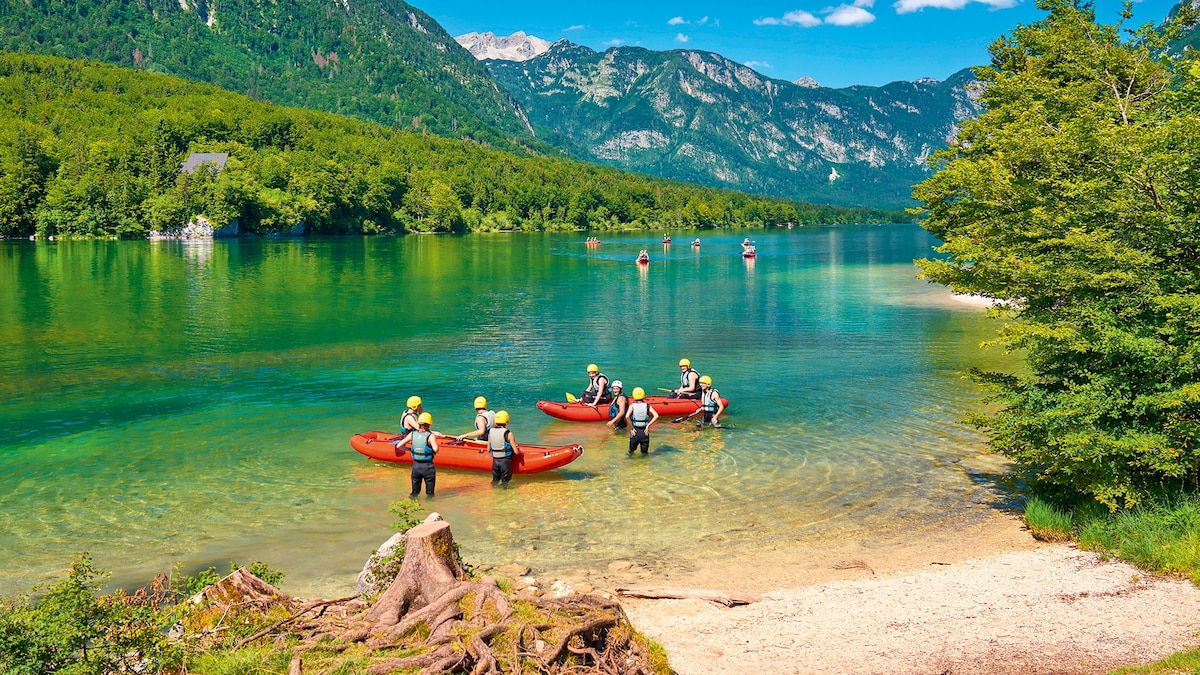This article was produced by National Geographic Traveller (UK).
While the Alps is known primarily as a winter playground, the mountain range is emerging as a summer destination. New and discounted rail links across Europe are making the peaks an attractive no-fly break for travellers. Due to unpredictable winter snowfall, especially at lower altitudes, local businesses and operators are expanding their year-round offering. And this year, big new openings, anniversaries and events are adding to the appeal.
1. Celebrate the anniversary of one of the Alps’ oldest national parks
Slovenia’s Triglav is marking its centenary in 2024 with a slew of events, including exhibitions and guided tours. Nudging the Italian and Austrian borders, the park’s a 324sq-mile, forested beauty, capped off by 2,864m Mount Triglav and packing in Alpine ravines, caves and rock faces. Lakes Bled and Bohinj are local showstoppers, but less-visited corners where you can swerve the crowds touch deeper still — whether you’re whitewater rafting the Soča River or holing up in an off-grid mountain lodge.

Last summer, the Austrian resort of Galtür launched over 300 new bouldering routes at the foot of the Ballunspitze mountain.
Photograph by Getty Images
2. Visit the Alps’ first European Capital of Culture
With mountains rising above crystal-clear lakes, Austria’s Salzkammergut has long been a magnet for wellness enthusiasts and anyone with two poles to hike with. The region is having its moment in the spotlight as one three European Capitals of Culture for 2024, with the local hub of Bad Ischl the banner town. The first rural, Alpine destination to wear the mantle, it’s going all out with a roster of events blending tradition and innovation: art exhibitions, theatre productions, digital projections and DJ sets are all on the calendar.
3. Cycle the Slovenian mountains
Pioneered by Slovenian NGO GoodTrail, the 2,090-mile Trans Dinarica Cycle Route is set be fully completed in summer 2024. It’s the first two-wheel itinerary of its kind to link all eight countries in the Western Balkans, with an emphasis on mountain biking. The route begins in Slovenia’s northwestern reach, close to the Italian border. In this mountain corner, the Julian Alps soar above glacial lakes, limestone gorges, timber shepherd’s huts and silent forests of spruce, beech and pine — a vision of the Alps before the dawn of tourism.
4. Explore the peaks by train

France is set to launch a new monthly rail pass covering the length and breadth of the country — for just €49 (£42).
Photograph by Getty Images, iStockphoto
The newly launched high-speed ÖBB Nightjet train brings the mountains within reach as it journeys from Munich, Germany to Warsaw, Poland. En route, it pulls in at Rosenheim, which lies in the foothills of the Bavarian Alps, and Salzburg, the springboard for the Austrian Alps, plus Linz and Vienna. Austria’s national railway is also launching new-generation Railjet trains set to offer passengers greater comfort on the Brenner route from Munich to Verona, Italy via Innsbruck and Bolzano, in the Dolomites. Elsewhere, France is set to launch a new monthly rail pass covering the length and breadth of the country — including Chamonix, Chambéry, Grenoble and other Alpine stations. Hot on the heels of Germany’s new single rail Deutschland-Ticket, France’s Pass Rail will cover unlimited use of TER (regional express trains), Intercités (intercity trains) and local transport.
5. Visit one of the Bavarian Alps’ beloved castles
One of Germany’s most recognisable locations, Neuschwanstein is a castle straight out of a bedtime story, its turrets and towers said to have inspired those featured in Disney’s Cinderella and Sleeping Beauty. The castle’s €20m (£17m) makeover, the biggest in its 150-year history, will be complete in 2024. Pigments, paints and gilding have revived lavish friezes. A 13ft-high Bohemian chandelier has been lovingly restored, wood has been waxed, stone polished. The castle is once again fit for the most eccentric of kings.
(How to plan a road trip in the Bavarian Alps.)
6. Taste award-winning cuisine in the Julian Alps
Mountain cuisine is having a moment in Slovenia. With self-taught chef Ana Roš at the helm, Hiša Franko in Kobarid has been awarded three Michelin stars — a first for the country. It elevates foraged, fished and fermented ingredients to giddy heights, from tagliolini with mountain rabbit, cacao and black truffle to honey brioche with beeswax, pear and chamomile. Over In Kranjska Gora, newly two-starred Milka walks the culinary high wire between Alpine and new-Nordic — think brown trout with juniper branches or roebuck with dark beer and plum.
7. Reach new heights
Open in 2024 for its first full summer season, the Matterhorn Alpine Crossing is the highest cable-car ride in the Alps. The 90-minute, all-season ride crosses the Theodul glacier from Zermatt, Switzerland to Breuil-Cervinia, Italy offering eye-on-stalks views of four-thousanders and a midway stop at the 3883 Matterhorn Glacier Paradise, the highest mountain station in the Alps. Time it well and you can take a morning hike in the shadow of the Matterhorn fang, then recharge with a lunch of carbonada (beef stewed in wine and spices) and local wine in Breuil-Cervinia.
8. Dine at high altitude in Switzerland
Swiss starchitect Mario Botta has been hard at work rebuilding the restaurant at Glacier 3000 in Vaud’s Les Diablerets, set to open in summer 2024. Fire ravaged his last restaurant here in 2022, but rising from the ashes will be a 400-seat, two-floor space that mirrors the surrounding landscape in its design, runs on solar power and is topped off by a panoramic terrace. After a meal, enjoy uninterrupted views of the Matterhorn and 24 other mountains of more than 4,000m from the Peak Walk by Tissot, the only suspension bridge in the world to connect two peaks.
Published in the Alps guide 2024, distributed with the May 2024 issue of National Geographic Traveller (UK).
To subscribe to National Geographic Traveller (UK) magazine click here. (Available in select countries only).





